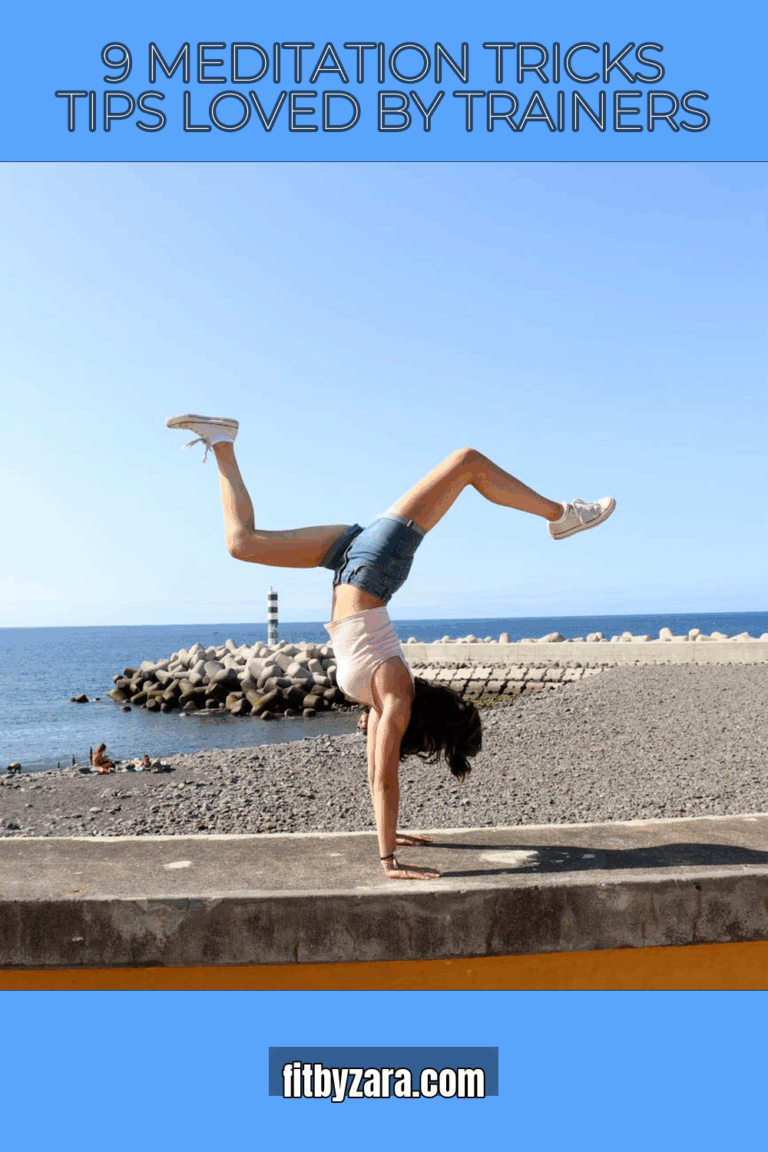Meditation isn’t just a buzzword; it’s a powerful tool for enhancing your overall well-being. As we navigate our 30s and beyond, integrating mindfulness practices can be a game-changer for stress management, emotional resilience, and mental clarity. If you’re ready to dive in, here are nine meditation tricks and tips that trainers swear by. Let’s make your meditation practice as effective and enjoyable as possible!

Hi, I’m Zara — fitness junkie, wellness nerd, and the voice behind FitByZara.com. This site is all about smart fitness and science-backed wellness tips for real women who want to feel their best.
1. Create Your Sacred Space
3-Day Energy & Metabolism Reset
Grab the 3-Day Energy & Metabolism Reset — a quick-start guide to feel lighter, more energized, and back in control.

Where should I send your free reset guide?
Why It Matters
Having a dedicated space for meditation can help signal to your brain that it’s time to unwind and focus.
Tips for Setting Up:
- Find a quiet corner in your home.
- Add personal touches like candles, crystals, or plants.
- Keep it clutter-free to promote calmness.
Mini Checklist:
- [ ] Choose a location.
- [ ] Add calming elements.
- [ ] Ensure it’s free from distractions.
—
2. Start Small
Why It Matters
If you’re new to meditation, starting with just a few minutes can make the practice less intimidating and more sustainable.
Tips for Beginners:
- Begin with 5 minutes daily, then gradually increase.
- Use a timer to avoid clock-watching.
- Focus on consistency over duration.
Mini Checklist:
- [ ] Set a timer.
- [ ] Commit to 5 minutes.
- [ ] Increase time as you get comfortable.
—
3. Incorporate Breathing Techniques
Why It Matters
Breathing exercises help ground you and enhance your focus during meditation.
Techniques to Try:
- 4-7-8 Breathing: Inhale for 4 seconds, hold for 7, exhale for 8.
- Box Breathing: Inhale for 4, hold for 4, exhale for 4, hold for 4.
- Deep Belly Breathing: Focus on expanding your belly as you inhale.
Mini Checklist:
- [ ] Choose a breathing technique.
- [ ] Practice for a few minutes before meditation.
- [ ] Observe how it changes your mindset.
—
4. Use Guided Meditations
Why It Matters
For those who find it hard to meditate in silence, guided meditations can provide structure and ease.
Where to Find Them:
- Apps: Headspace, Calm, Insight Timer.
- YouTube Channels: Search for guided meditations tailored for your needs.
- Podcasts: Many wellness creators offer free meditation sessions.
Mini Checklist:
- [ ] Download a meditation app.
- [ ] Explore various guided sessions.
- [ ] Try a few different voices/styles to find your favorite.
—
5. Experiment with Different Styles
Why It Matters
Every person is unique, and so are meditation techniques. Discover what resonates with you.
Styles to Explore:
- Mindfulness Meditation: Focus on the present moment.
- Loving-Kindness Meditation: Cultivate compassion for yourself and others.
- Transcendental Meditation: Use a mantra to settle your thoughts.
Mini Checklist:
- [ ] Research different meditation styles.
- [ ] Try each style for a week.
- [ ] Reflect on which style felt right for you.
—
6. Use Affirmations
Why It Matters
Affirmations can help set positive intentions and promote a growth mindset during meditation.
Example Affirmations:
- “I am calm and centered.”
- “I embrace change and growth.”
- “I am worthy of love and happiness.”
Mini Checklist:
- [ ] Write down your favorite affirmations.
- [ ] Incorporate them into your meditation practice.
- [ ] Repeat them silently or aloud.
—
7. Keep It Consistent
Why It Matters
Regularity is key to developing a satisfying meditation practice.
Tips for Consistency:
- Set a specific time each day (morning, lunch, evening).
- Pair meditation with an existing habit (e.g., after brushing your teeth).
- Use reminders or alarms to help you stay accountable.
Mini Checklist:
- [ ] Choose a daily meditation time.
- [ ] Link it to another established routine.
- [ ] Set reminders to keep you on track.
—
8. Be Kind to Yourself
Why It Matters
It’s natural for your mind to wander. Practicing self-compassion can enhance your meditation experience.
Strategies for Self-Kindness:
- Acknowledge when your mind drifts without judgment.
- Gently bring your focus back to your breath or mantra.
- Celebrate small wins, like completing a session, regardless of how it felt.
Mini Checklist:
- [ ] Recognize wandering thoughts as normal.
- [ ] Create a mantra for self-compassion (e.g., “It’s okay to be human.”).
- [ ] Celebrate your commitment to the practice.
—
9. Reflect on Your Experience
Why It Matters
Taking time to reflect helps you gauge your growth and adapt your practice.
Reflection Techniques:
- Journaling: Write about your feelings before and after meditation.
- Mood Tracking: Note how meditation influences your mood throughout the day.
- Self-Check-Ins: Ask yourself how you felt during the session and what you’d like to change.
Mini Checklist:
- [ ] Set aside time to journal after meditation.
- [ ] Use mood tracking apps if desired.
- [ ] Regularly assess your meditation journey.
—
*”Meditation is a journey, not a destination. Embrace each moment and be gentle with yourself.”*
—
Final Thoughts
Meditation can be a transformative practice that enhances your life in numerous ways. Remember that everyone’s journey looks different, so don’t hesitate to experiment with these tips to find what feels best for you. Whether you’re new to meditation or looking to deepen your practice, these tricks will help you cultivate a meaningful and consistent routine.
So, what are you waiting for? Grab your favorite cushion, find your sacred space, and dive into the world of mindfulness. Happy meditating!
HepatoBurn: Gentle Support for Steadier Days
When you’re stacking real habits—protein-forward meals, steps, and 7–9 hours of sleep—HepatoBurn is a simple add-on that supports the system behind energy, appetite, and metabolic rhythm.
Why Women 30+ Use It
- Pairs with an already-solid routine—no jitters, no crash.
- Easy to remember: 2 capsules with meals.
- Plays well with protein, walking, and strength training.
How to Use
- Timing: Breakfast & lunch are easy wins.
- Consistency: Use daily for a fair assessment.
- Stacks: Protein-first plates, post-meal walks, lights-down wind-down.
What It Isn’t
- Not a stimulant and not a magic fix.
- Best used alongside habits you’ll actually keep.
- Educational only—talk to your provider before new supplements.
Important: Educational only, not medical advice. Supplements don’t diagnose, treat, cure, or prevent diseases. Talk to your provider before changes to diet, exercise, or supplements.






















